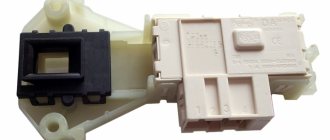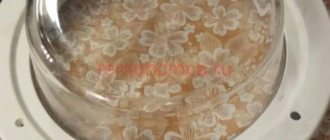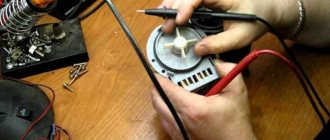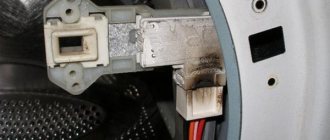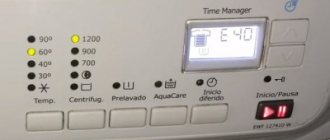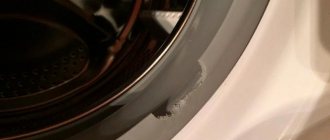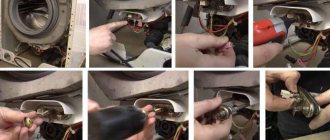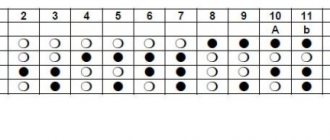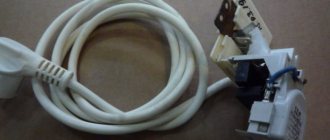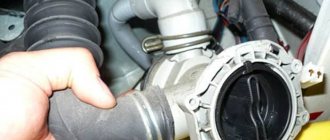External damage
The lock may not close due to normal wear and tear or rough handling. For example, sometimes wet things are hung on the door, which with their weight can damage the mechanism. Damage may also occur if the unit is closed with excessive force.
The device may not close for several reasons:
- As a result of prolonged use, the washing machine door was warped.
- The locking tab in the lock mechanism was misaligned.
- The plastic element or rubber gasket has worn out.
Identifying this type of fault is not difficult. To check, you can perform a test closure in normal mode, without loading laundry. If the door does not close under such conditions, it means that the lock has broken down or the fastening is skewed. Sometimes this may be due to improper installation, and then in an uneven position the hatch may warp under the influence of weight and vibrations. How to install a washing machine correctly - read here.
You can debug the operation of the machine yourself. Carefully inspect the device and locking mechanism. Check:
- Are there any objects preventing it from closing? Sometimes things can completely or partially fall under the hatch and jam the system.
- Condition of the locking hook: does it fit into the groove?
- Is the locking tab in place properly?
- Signs of peeling of plastic or rubber gasket.
Problems with the lock hook
The machine door is locked with a hook that ends the shutter rod. It is this hook that should fit into the socket and secure the structure. As a result of wear, vibration and other factors, the supporting rod may move out of its place and not fall into the socket at the moment of closing. The door may not close or may close without the door closing sensor operating.
The problem can be solved this way: dismantle the hatch door and unscrew it around the perimeter. Open the hatch parts, install the hook base in place and assemble everything in reverse order.
Hatch door sagging
The door frame is usually made of plastic. All fasteners (hinges) are made of metal. Plastic is softer than metal, and over time it wears out and deforms at the point of contact. As a result, the hatch door may sag, and as a result, the lock hook does not go where it is supposed to when closing. In such a situation, it is necessary to replace either the entire door or the fastening parts. This can be done using the following algorithm:
- remove the hatch door;
- disassemble it and replace damaged elements;
- put the door in place.
Over time, the hatch door may sag
Broken door handle
The assembled lock mechanism consists of the following elements: handle, lock hook, lock rod, spring. Breakage of any part results in the door not locking or closing/opening.
According to statistics, the door handle most often fails, since it is subject to the most active influence from the user. To replace any of the listed parts, you need to disassemble the entire door and replace the handle.
The most common thing to break is the hatch door handle.
To repair the handle:
- unscrew the door;
- disassemble it into components;
- remove the old handle;
- install a new part;
- assemble the door and install it in place.
The washing machine hatch does not close: when the cause is a mechanical failure
Possible malfunctions when the door does not close mechanically are related to the fastening and lock of the hatch. In both cases, everything is fine with the UBL, but the latch does not work because there is no correct contact with the lock. Here are the main breakdowns.
The door has moved due to wear or damage to the hinges - from RUB 1,100*
The hatch is held in place by one or two hinges. On older machines, the fastening weakens due to natural wear and tear of the hinges or their mounting holes on the body. On new equipment, the cause is often mechanical damage. For example, a child rolled on the door or something heavy was dropped. Due to subsidence, the locking tongue and groove on the body do not match in height. The door closes crookedly and the latch does not catch the lock tongue.
The technician will adjust the fastening or replace the hinges.
The lock rod fell out - from 1100 rubles*
The rod keeps the tongue in the correct position. Without it, the hook moves to the side, dangles and does not fit into the groove. Therefore, it is not fixed by locking.
The technician will disassemble the door, check the lock, and replace the rod if it is intact. A broken lock will have to be replaced entirely, sometimes along with the handle. It is very rare, but damage to the plastic elements of the door itself occurs due to attempts to close it with great force. In this case, the hatch is completely replaced.
Failure of the hatch locking device (UBL)
On the machine side, the process involves a hatch locking device (UBL). Its purpose is to lock the lock and not open it until the washing cycle is completely finished (all this time voltage is supplied to the UBL), thereby preventing unauthorized opening of the door and water spillage. The UBL can fail for two reasons: there is a breakdown in itself, or there is no voltage going to it.
The body of this device is made of plastic. The lock is locked under the influence of current, which simultaneously heats the mechanism. This leads to damage to the plastic and its deformation. As a result, the entire node becomes inoperative.
The second option is mechanical failure as a result of the shock load to which the UBL is exposed during washing/spin due to vibration of the machine. In any case, there is only one solution to the problem - replacing the block. You can do this yourself:
- pull out the spring securing the hatch cuff;
- unscrew the UBL fasteners;
- remove the block by disconnecting the contacts (after writing down, or better yet photographing, which wire goes to which contact);
- Attach the contacts to the new part in the correct layout (based on the photo taken a step earlier), secure the UBL in its place.
How to fix the problem?
Hook lock
On washing machines, the hook that is inserted into the lock for subsequent locking is held on a metal rod. Over time, the rod moves out of place and the hook moves and does not fit properly. The blocking cannot work in this case. For the same reason, the door may not close at all.
To fix this, you need to remove the hatch, unscrew the screws around the perimeter of the hatch, halve the hatch and put the rod in place where it is attached.
Video instruction: returning the hook to its place on the Indesit WIU61.
Luke
All hatches are made of plastic, and the hinges on which the hatch is held are made of metal. Over time, the metal begins to eat away at the plastic due to friction and backlash appears . The positions of the hatch and the hook are shifted, in which case the hook cannot get into place, the same thing happens when the rod is displaced, which we considered earlier. In such cases, the hatch itself or its parts responsible for holding the hatch in a certain position are replaced.
To troubleshoot:
- Remove the hatch.
- Unscrew the screws around the perimeter and halve it.
- Replace the damaged parts with new ones and reassemble the hatch in reverse order.
Opening mechanism
The opening mechanism includes: a hatch handle, a hatch hook, a spring and a rod on which the hook is held. If any of these components fail, the hatch will not lock or open .
To fix this problem, you will have to disassemble the hatch and replace the broken part. Most often it is the hatch handle.
For this:
- We remove the hatch.
- We unscrew the screws around the perimeter of the hatch.
- Let's halve it.
- Remove the broken handle.
- We put a new one in its place.
- Reassemble in reverse order.
Video instruction: replacing a broken hatch handle on an Indesit WS105TX.
Electrical and electronic problems
The washing machine door may not lock if the contacts to the lock, UBL or sensors are broken. This often happens due to strong vibration of the machine. You can find a break by simple inspection. A soldering iron and electrical tape will help solve the problem.
Another situation: failure of the control unit. In this case, the processor simply does not issue commands to lock the lock, as a result - the door is not closed and the wash does not start. Visually, you can find melted or torn elements on the control unit board. In this case, the best thing you can do is call a service technician.
The washing machine does not block the door - reasons and possible malfunctions
If everything is in order with the lock and fastening of the door, it closes correctly, but does not lock. In this case, the reasons are related to the failure of the locking device or control unit.
Faulty UBL - from 1200 rubles*
The task of the UBL is to fix the lock hook in the closed position so that the hatch does not open while the machine is operating. If the device breaks down, it does not lock the door, so the machine does not draw water and does not wash.
The blocking device receives a signal from the control module after the program starts. The mechanical latch of the lock extends under the action of a bimetallic plate, which heats up after voltage is applied to the UBL, and blocks the hatch. The bimetal gets tired over time, and the plate becomes deformed, so the latch does not extend completely. Sometimes the bimetallic plate breaks and the locking fails completely.
The technician will replace the non-functioning blocking device with a new one.
The control unit has failed - from 1800 rubles*
UBL receives a command to lock the lock from the control board. If the unit is faulty, the lock does not work and the machine does not start drawing water and washing.
The reasons for the failure of the block are burnt out elements, burned out tracks or contacts on the part of the board responsible for the blocking device.
The technician will check the board, replace faulty radio components, and restore tracks and contacts. It is rare, but it happens that the processor of the microcircuit fails. In this case, the control unit is replaced entirely.
Why else are you unable to hermetically close the washer hatch?
If mechanical reasons due to which the door does not close are not your case, then the reason may be hidden in the washing machine itself.
The door can be closed, but the hatch does not lock
Firstly, the device responsible for blocking the hatch (UBL) could fail.
The UBL needs to be replaced.
Secondly, a small object that got there from clothing could have become clogged in the UBL.
The technician disassembles the device and removes the blockage.
Thirdly, there could be a breakdown of the electronics - the electronic control module, which does not give a signal to the UBL to block the hatch.
The board needs to be reprogrammed or replaced altogether.
The lock does not perform its function
If the mechanical lock latches, but the wash still does not start, then there are problems with the UBL. The hatch locking device is activated automatically at the start of each cycle, further protecting the user from accidental opening of the drum during operation of the equipment. In the event of a breakdown, the blocker does not work; the Beko board detects the absence of a signal and, for security reasons, cancels the program.
Problems with UBL arise for a number of reasons:
- device clogged;
- blocker failure;
- manufacturing defects;
- loss of connection with the control board.
A clogged blocker can be easily returned to service. It is enough to dismantle the UBL, disassemble it and clean it of accumulated lint and dust. If the bimetallic plate in the mechanism breaks or a short circuit occurs, then replacement is indispensable.
The electronic lock on the Beko washing machine is not activated if the UBL fails or the control board is broken.
It's worse if the control board is broken. If the software fails, the microcircuits burn out, or the tracks and contacts are damaged, the UBL does not receive a blocking signal, the washing machine remains open. This situation can be caused by power surges, chaotic key presses on the dashboard, or a one-time technical glitch. To find out the cause and eliminate the consequences, you will have to carefully inspect the module, reprogram it and repair it. It is not recommended to deal with the electronic unit on your own - diagnostics of the “brains” should only be carried out by professionals.
